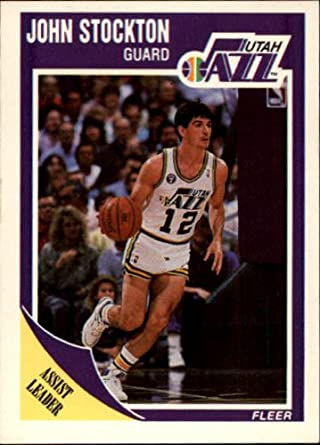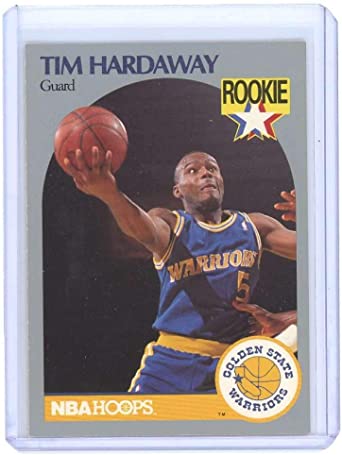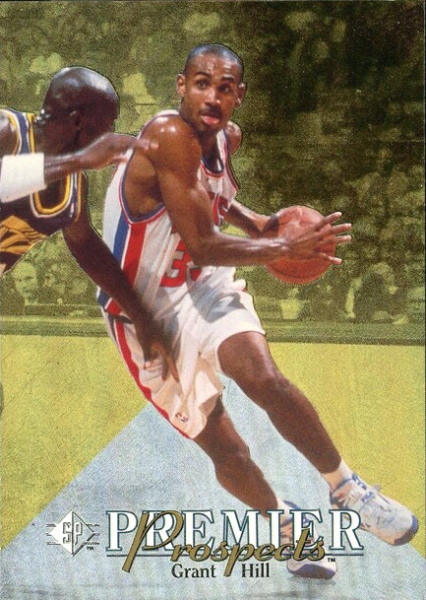Finding Underrated Basketball Cards of the Junk Wax Era

We’ve written, at some length, about the formative and transformative periods in the history of basketball cards. We all know the drill by now: star-studded 1961-62 Fleer gives way to, well, nothing for the better part of a decade. Topps redefines the hobby, first with its legendary 1969-70 set, then as the only game in town until early 1980s. Topps makes for the exit, again, leaving the door open for Star’s pack-less but star-studded mid-decade reign. After three years, Star gives way to Fleer, and its Holy Grail 1986-87 set.
This time Fleer sticks around. Its follow-up 1987-88 product underwhelms. Following ’86-’87 set was always going to be an unenviable task. That task was made impossible by the tragic death of the astoundingly skilled and spectacularly athletic second pick in the 1986 draft by the Boston Celtics – and nailed-on generational superstar – Len Bias. Cavaliers big man Brad Daugherty looked like he might carry the mantle, though his was a style of play that, while effective, didn’t excite.
The remaining rookie crop of Ron Harper, Detlef Schrempf, Dale Ellis, A.C. Green, Jerome Kersey, Terry Porter and Otis Thorpe, was long-lived and very successful, but lacking in star power. Thankfully, Michael Jordan, Magic Johnson, Larry Bird, and most of the Dream Team were around, as was the final card from Julius Erving’s career, and another batch of one-per-pack stickers.
The last true “vintage” basketball product, Fleer’s 1988-89 set, is loaded with top rookies, thanks to a small scale ’86-’87-style rookie card accumulation The set features the regular issue rookie of a top-five all-time point guard (John Stockton, whose cardboard debut actually came in 1984-85 Star), and rookies of an iconic two-way superstar (Scottie Pippen), a generational rebounder and defender (Dennis Rodman), and one of the game’s greatest-ever shooters (Reggie Miller).
By the end of the decade, basketball cards were far more prominent in the hobby. In fact, for the 1989-90 season, for the time ever, two mainstream NBA products hit the market, as Fleer was joined by NBA Hoops. Thanks to the massive popularity of the league’s superstars, both Fleer and Hoops – and beginning in 1990-91, Skybox – produced more basketball cards than the hobby had seen before. Unfortunately, this ramp-up coincided with a period in which the NBA struggled to produce stars at anywhere near the same rate.
Thanks to injury and underachievement, over a six-year-stretch, Shaquille O’Neal and David Robinson were the NBA’s only enduring superstars. Granted, along the way the the spectacular talents of Penny Hardaway, Grant Hill and Larry Johnson were lost to injury. Meanwhile, Chris Webber and Gary Payton needed time to bloom into stars. And, despite a phenomenal resume and a funny commercial or two, Dikembe Mutombo inspires only so much excitement. Meanwhile, the likes of Purvis Ellison, Glenn Robinson, Derrick Coleman, Kenny Anderson, Jimmy Jackson and Jamal Mashburn never developed into legitimate stars, let alone faces of the league.
Welcome to “junk wax”!
With the notable exceptions of all things Michael, and many things Robinson and Shaq, it’s tough to think of a basketball card produced between 1989-90 through 1994-95 that truly matters. This more than a little unfair. First, not everything was produced without regard for the concepts of supply, demand and value. And there were other players whose contributions mattered, with cool and reasonably relevant cards:
1989-90 Fleer Scottie Pippen (#23) and John Stockton (#156)

Residing in a strange spot in between Fleer’s strongest efforts and true junk wax, 1989-90 Fleer is the set that time forgot. Theoretically, this set has plenty to sink your teeth into. The rookie lineup features six future All-Stars – Mitch Richmond, Jeff Hornacek, Danny Manning, Kevin Johnson, Rod Strickland and the late Reggie Lewis – one of whom (Richmond) is a Hall of Famer. For the last time, we’ve got the stickers. And, of course, there’s Jordan, whose fourth Fleer card harkens back to ‘86, with Mike swooping in for a dunk.
And yet, the whole thing falls flat. Centering and printing issues keep the raw eye appeal from reaching its potential. Plus, though Fleer’s rookie crop is technically impressive, one rookie card from this year matters – and Fleer didn’t make it!
Lost amid this are second-year cards of a pair of all-time greats: Scottie Pippen and John Stockton. Given the incredible on-court significance of these two Dream Teamers, that these cards battle (not terribly successfully) to simply achieve “afterthought” status is a bit puzzling.
Each is more aesthetically pleasing than its ‘88-‘89 counterpart, with Pippen captured directing the Bulls’ offense, and Stockton bringing the ball up the floor. Also, those centering and printing issues that work against this set ought to have boosted the collectability of high-quality versions over the years.

(If you don’t immediately know which cards I’m referring to, don’t fret – you’re not alone.)
And yet, three decades on, each remains, basically, anonymous. Consider that there are nearly as many PSA 10 Jordans (971) in existence as there are there are total PSA-graded versions of Pippen and Stockton combined (1,068). Strangely, where this should qualify as rarity, here it just feels like more obscurity.
There are 426 Pippens in PSA 9, and 214 in PSA 10. Mint versions have never consistently cracked $100, and only during a meteoric market-wide boom did the 10s crack $200. Stockton is rarer still, with just 221 graded versions in existence, just 93 apiece in PSA 9 and PSA 10. Each can be had for at least 20% less than the comparable Pippen.
It’s would be reasonable, at current prices, to assume that these surprisingly rare Fleer follow-ups will one day get a day in the sun. Alas, we are, talking about basketball’s Bermuda triangle, so…
1989-90 NBA Hoops David Robinson (#138)

We mentioned him above – the plan was to leave it at that. “The Admiral” was about as over-the-radar as it got in the early-90s. However, in the moment, omitting this card feels like a dereliction of duty.
It’s tough to imagine now, but this is one of the most significant cards in hobby history. A new manufacturer, debuting in 1989, anchored by the flagship (in this case, only) rookie card of a generational, can’t-miss prospect who did NOT miss… This is basketball’s 1989 Upper Deck Ken Griffey Jr.
Circa, 1991, the only non-Star cards from the preceding decade that definitely would have been chosen over the “Robinson jersey” (as it was known on the playground) were the Magic/Bird rookie and the 1986 Fleer Jordan. And the notion that this would one day occupy a similar spot in the hobby was not crazy.
Like Griffey, Robinson was the top pick in the 1987 draft. His arrival in the NBA was delayed for two years by service at the Naval Academy. Once he did arrive, his impact was positively astounding. A rookie as physically and mentally mature (he was 24 years of age) as any in league, history, Robinson’s was a debut season for the ages.
He played all 82 of the Spurs’ games, averaging 24.3 points, 12 rebounds and 3.9 blocked shots per game. He posted a Player Efficiency Rating of 26.3, and 15.1 Win Shares. In NBA history, only Wilt (1959-60) and Walt Bellamy (1961-62) had more Win Shares as rookies, and only Wilt had a higher rookie-year PER. In over 30 years since, only Shaq, Tim Duncan, Chris Paul and Karl-Anthony Towns have notionally come close to either mark. They, in fact, did not come close.
Robinson powered the Spurs to a ridiculous thirty-five win improvement and the #2 seed in the West. He was, deservedly, an All-Star, All-NBA, and the unanimous Rookie of the Year.
It’s fitting that a season for the ages is marked by a single, eminently memorable – and short-printed – rookie card. It’s certainly cheap and for collectors and fans of a certain age, this card will forever resonate.
1990-91 Fleer Rookie Sensations Tim Hardaway (#8 of 10)

The following year, Fleer became the first basketball producer to dip a toe into the Lake Insert. Having done away with the stickers, Fleer introduced Rookie Sensations, inserted at a rate of one-per-five retail-only jumbo/cello packs. The unquestioned headliner is David Robinson, though the set also featured are a couple of other stars-to-be, in Glen Rice and Tim Hardaway.
The fourteenth pick in the 1989 draft, Hardaway wasted no time in making an impact. A scoring lead guard in the mold of Nate Archibald and Isiah Thomas, he averaging just under 15 points and nine assists as a rookie, earning First Team All-Rookie honors. He was a revelation, teaming with Chris Mullin and Mitch Richmond to form “Run TMC”. Though Mullin was a Dream Teamer and Richmond the reigning Rookie of the Year, Hardaway’s “UTEP two-step” crossover and playmaking were what made the Warriors’ electric offense go.
He’d later team with Alonzo Mourning in Miami, authoring the first era of success in Heat history. Though Hardaway was arguably a better player than any of his star teammates, he’s the only not yet enshrined in the Hall of Fame. This will likely be rectified in the not-too-distant future.
Unsurprisingly, David Robinson’s Rookie Sensation is the set’s headliner. At the time of writing, 1,051 have been graded by PSA, with shockingly small number (185) deemed Gem Mint.
Meanwhile, only 367 Hardaways have been graded by PSA. Interestingly, 27.5% (101) have received a Gem Mint 10 grade. It’s fair to wonder, however, just how many more picture perfect versions remain, as, at the time of release, Robinson was only the real prize, with everything else largely an afterthought.
While we’re on the subject…
The most popular and valuable of Hardaway’s three rookie cards is his 1990-91 Fleer. However, Hardaway’s 1990-91 Hoops rookie (#113), its sharp silver borders, cool “Rookie” insignia, and a nice action shot, is arguably his easiest on the eyes, yet most overlooked rookie card. Those sharp borders are something of a blessing and curse, as their condition-sensitivity offsets, to some degree, a print run of… carry the two… eh, let’s call it a billion. I kid…mostly.

And yet, while 952 of Hardaway’s Fleer rookie have been graded by PSA, with a staggering 403 (42.3%!) earning a Gem Mint 10, and another 431 a Mint 9, Hardaway’s Hoops card has been slabbed just 193 times, with only 77 carrying a 9 grade, and just 47 (24.3%) earning a 10.
That year brought the cardboard debut of another dynamic Pacific Division point guard. Drafted the summer after Hardaway, second overall by the Seattle Supersonics, Gary Payton was no draft sleeper. Also unlike Hardaway, his impact was far from immediate. In fact, over his first two seasons, GP averaged eight points and six assists, and graded out as an average player.
However, once “the Glove” hit his stride, he didn’t look back. In his last ten full seasons in Seattle (beginning with his third season, 1992-93), Payton averaged 20 points, 7.5 assists and more than two steals per game, earned nine All-Star selections (would have been ten, had a lockout not scrapped the 1999 game), nine All-NBA selections, eight top-ten MVP finishes, nine consecutive First-Team All-Defense nods, and the 1995-96 Defensive Player of the Year award.
His impact on NBA culture was every bit as profound. In many ways, Payton is the spiritual forebear to Allen Iverson and fellow Oakland native Damian Lillard. His breathtaking partnership with Shawn Kemp (captured beautifully in Skybox’s 1992-93 “Thunder and Lightning” insert set) introduced the league to an previously unsampled flavor of cool. Not only did the duo power the Sonic to the NBA Finals, they laid the foundation on which Lob City was later built – and did so with an unforced, irreverent swagger to which just about every star since has aspired.
While Kemp was deservedly celebrated for his incredible combination of speed, power and above-the-rim finishing, the slower-developing adulation for the man from whom those lobs originated will be longer lived. Payton is still largely seen as a player “of his era”. In reality, he’s one of absolute best players in NBA history. He ranks behind only Magic, Oscar, Chris Paul and Stockton in career Win Shares among point guards, and sits 25th among all NBAers. Just fourteen players have eclipsed Payton’s 72.5 post-age-30 Win Shares – just two of them, Stockton and Steve Nash, are point guards.

Like Hardaway, Payton’s most popular and valuable rookie card is , in a neck-and-neck battle, his 1990 Fleer Update and Skybox cards, both of which have been graded 1,100+ times by PSA, with more than 25% deemed Gem Mint, and more than 80% of each earning either a 9 or a 10. As with Hardaway, Payton’s 1990 Hoops rookie (#391) remains undergraded and underappreciated in the hobby. PSA 9s and 10s make up proportionately similar chunk of the population (compared with Fleer ad Skybox), but, with PSA having graded just 601, the 215 10s and 248 9s aren’t aren’t exactly easy to find. With price tags about 35% and 75% below their Skybox and Fleer counterparts, there’s a decent chance they become rarer still.
Before we move on, let’s spare a thought for the 1992-93 Fleer Rookie Sensations, which feature the NBA’s draft class of 1991. The class, headed by Mutombo, Larry Johnson and Steve Smith, doesn’t lack for talent. Unfortunately, none of three ever achieved the level of superstardom that translates into lasting hobby cachet. None the less, they headline in one of the most visually engrossing card designs of the modern era.

1993-94 NBA Hoops Draft Redemption Chris Webber (#DP1)

Chris Webber is, if nothing else, one of the most significant basketball players of the 1990s, if not all time. He was the talisman (along with Juwan Howard and Jalen Rose) of Michigan’s Fab Five. The precocious crew not only powered its way to the NCAA titles game in both their freshman and sophomore years, but did so in a manner that made them icons. Young, brash, scowling, and wearing the baggiest of shorts and short black socks… they were college basketball’s Miami Hurricanes.
The head of the “worst great draft class in NBA history”, Webber’s genuine greatness with the Sacramento Kings is, unfortunately, historically subordinated to memories of some rather conspicuous defeats in the postseason – and awards voting – to Charles Barkley, Karl Malone, Tim Duncan, Kevin Garnett, Shaq, Kobe and Dirk Nowitzki. That might seem reasonable for the bluest of blue chip prospects that never fully get over the hump. And yet, to say that he did not deliver on his promise does C-Web a huge disservice.
A combination of size, power, speed, agility and savvy seldom seen in a big man, Webber was a Rookie of the Year, five All-Star and All-NBA selections, five top-ten finishes in MVP voting, and career averages of just under 21 points and 10 rebounds, and more than four assists and a block and a steal apiece. All this, despite chronic injuries that derailed the back half of his career. Like Hardaway, it’s only a matter of time before the Hall of Fame comes calling.
An unacknowledged beauty from Webber’s “cardography” is the 1993 Hoops Draft Redemption. This is the most visually stunning of Webber’s rookie year issues, with a pitch black background that contrasts dramatically with the bright blue and yellow of the Warriors cap, and Webber’s gleaming smile. In addition to adding to the card’s aesthetic, those black edges and corners also make this card – and surprisingly rare to begin with – an extremely tough one to find in pristine shape. Consider: just 289 have been graded across both PSA (160) and BGS (129), with just 53 earning at least a Gem Mint (PSA 10/BGS 9.5+) grade.
Grant Hill 1994-95 SP rookie card (#3)

Grant Hill played thirteen healthy seasons in the NBA, racked up 99.9 Win Shares, seven All-Star and five All-NBA selections, five time finished in the top-ten in MVP voting, and cruised into the Hall of Fame.
That, despite all of that, his career is seen as something of a tragedy is a testament to the absurdity of his entrance into the league. Over his first half-dozen seasons, Hill averaged 21.6 points, 7.9 rebounds, 6.3 assists, 1.6 steals, made about 48% of his shots and, most impressively, missed a total of 25 games. Beyond the incredible, Hill provided a glimpse into a future that would be ruled by smart, savvy and obscenely athletic Swiss Army knives who could control and dictate all aspects of the game, at both ends.
Of course, despite his amazing rebound from a string of devastating ankle and back injuries around the turn of the century to unexpectedly author a delightful and successful second phase, it’s tough to wonder what might have been, if Peak Hill had had the opportunity to team up in Orlando alongside entering-his-prime Tracy McGrady. It’s one of the great “what ifs” of NBA history.
Maybe the best thing about the sports card hobby is its ability to transport us to a particular time and place. To a moment when unrealized potential is still a feature and not an albatross. Few cards from the 1990s better capture the sense of what was, what should have been and, frankly, inspire appreciation of what it was that we did get, than Grant Hill’s 1994-95 SP rookie card.
Between the condition sensitivity of the foil surface, which contrasts beautifully with the future Hall of Famer’s jersey, this is an underappreciated gem of the era. Consider, also, that, of 2,031 graded by PSA, less than 2.5% (49) have been deemed Gem Mint. Similarly, PSA 9s represent well under 25% (447) of that population and – you might to keep this yourself – are readily available for under $40.
One man’s junk…





